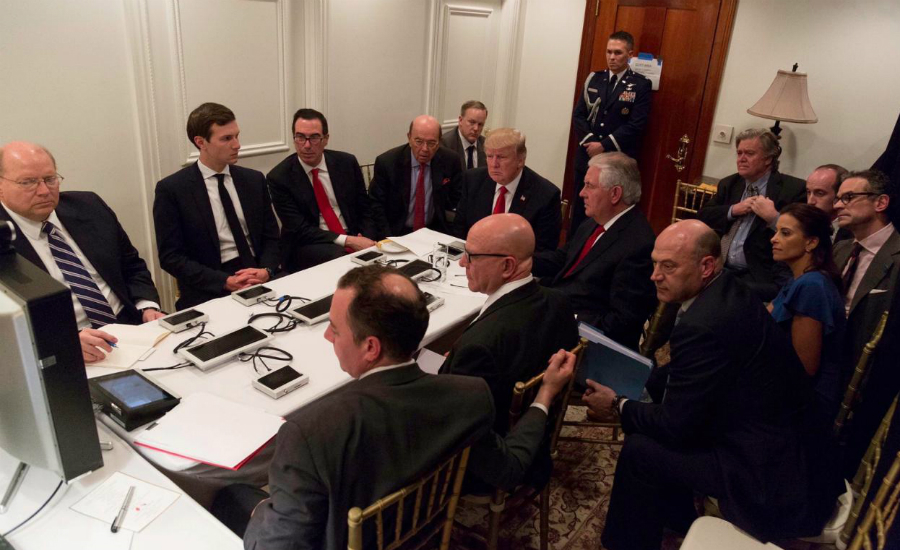Has Donald Trump Learned on the Job as Commander in Chief?
The administration's decision-making process seems as broken today as when the president entered office.

Published by The Lawfare Institute
in Cooperation With

Editor’s Note: President Trump is entering his fourth year as commander in chief, a time when many of his predecessors have learned from their early mistakes to lead a more effective foreign policy team. Rebecca Friedman Lissner of the Naval War College examines Trump’s performance, comparing him with other modern presidents. Lissner finds that Trump has failed to change his approach after his early mistakes and does not exhibit any of the characteristics that make successful learning more likely in the future.
Daniel Byman
***
Donald Trump assumed the U.S. presidency in January 2017 with no government experience—a record unique among modern presidents. Observers on the right and left noted with particular alarm his lack of national security credentials and apparent uninterest in educating himself about international relations during the 2016 campaign. Only five days after taking office, the risks of this inexperience seemed to manifest in a special operations raid gone awry. Targeting an al-Qaeda operative in Yemen, the Trump-authorized operation resulted in the death of a Navy SEAL, civilian casualties, and no capture. Nearly three years later, the president has accrued more national security experience, overseeing military interventions, negotiating with global leaders, and taking consequential decisions about U.S. trade relations. What has he learned as commander in chief?
Traditional academic approaches to studying presidential learning focus on substantive knowledge gained through experience—learning, for example, about the scope of a bargain North Korea might accept in nuclear talks or about Iran’s ability to tolerate economic costs imposed by sanctions. Equally salient, however, is what I call “foreign policy process learning” in a new Political Science Quarterly article. This approach looks for evidence of learning within the decision-making processes that produce foreign policy, rather than within policy choices themselves or their outcomes. Process learning is easier to detect than substantive learning; it is more readily evaluated according to objective criteria for effectiveness; and it is extremely consequential, as high-quality processes are far likelier to result in smarter policies. By this standard, President Trump has learned remarkably little as president and appears unlikely to do so over the remainder of his tenure.
Learning From Early Mistakes
Nearly every president makes foreign policy mistakes in their early days in office. The transition between presidents is fraught with misunderstandings as information gets lost between administrations, new teams get to know each other, and presidents grow accustomed to their responsibilities and authorities.
Perhaps the most infamous such example is the Bay of Pigs invasion, launched three months after John F. Kennedy assumed office, in April 1961. A covert operation to overthrow Fidel Castro, the Bay of Pigs was an utter disaster. The paramilitary invasion failed after only four days, and Castro emerged stronger and more adversarial to U.S. interests. This “perfect failure” reflected a flawed decision-making process: The invasion’s CIA advocates tightly restricted information necessary to evaluate prospects for success, the White House prematurely accepted the errant assumptions guiding operational planning, and the Kennedy administration never seriously considered what the United States would do in case of failure.
While the contours and causes of the Cuban fiasco are well known, the process learning that resulted from it receives far less attention. In the aftermath of the Bay of Pigs debacle, Kennedy and his White House team took several important steps to understand their mistakes. The president signaled his personal interest in learning from the Bay of Pigs and empowered a committee to formally investigate the fiasco’s causes, and his advisers sought to extract lessons from a humiliating failure. Consequently, the Kennedy White House came to recognize the need for a more systematic review of policy options at levels subordinate to the president, better mechanisms of information circulation, and differentiation between policy advocacy and evaluation roles.
The fruits of the Kennedy administration’s process learning manifested in its response to the Berlin Wall crisis of June 1961. Kennedy saw Soviet leader Nikita Khrushchev’s renewed aggressiveness in Berlin as a reaction to the misadventure at the Bay of Pigs; speaking to a journalist after meeting Khrushchev for the first time, Kennedy conjectured that failure in Cuba had made him seem “inexperienced and [like I] have no guts.” As the crisis intensified that summer, the administration’s decision-making process featured marked improvements: Information about crisis planning circulated throughout an interagency coordinating group, Kennedy’s advisers rigorously questioned emergent policy assumptions and voiced dissenting opinions, and planning featured extensive discussion of implementation as well as contingency plans. While it is impossible to prove that the Berlin crisis resolved peacefully as a result of this improved process, process learning likely contributed to this outcome.
Trump’s On-the-Job Learning
Trump, like Kennedy, entered office with little foreign policy experience, an ardent desire to distinguish himself from his predecessor, and a new team of advisers. He, too, experienced a humiliating, early failure in a military operation that originated under the prior administration but was ultimately authorized on his watch. Unlike Kennedy, however, Trump appears to have learned little from the Yemen raid. Indeed, years into his presidency, there is scant evidence that the national security decision-making process has improved meaningfully over time.
Trump’s decision-making process for the Yemen raid had several dysfunctional features. First, it lacked any meaningful interagency process. Rather than working through multiple layers of deliberation and vetting, it went straight to the president for authorization. Second, and even more unusual, the president approved the plan over dinner with a subset of his national security team—which was heavy on active-duty and recently retired military officers—but had no State Department representation. Third, in an echo of the Bay of Pigs planning process, advocacy and evaluation roles were undifferentiated, as then-Secretary of Defense James Mattis and then-Chairman of the Joint Chiefs of Staff Joseph Dunford briefed the Defense Department-generated plan and offered their “unreserved endorsement.” Ultimately, Trump provided a green light to a disastrous operation that resulted in a fallen Navy SEAL, the loss of an Osprey helicopter, and at least 16 civilian casualties.
The results of the Yemen raid were tragic—but they also offered a critical learning opportunity for a new and inexperienced White House. The president’s actions since, though, indicate that the lessons of the Yemen raid were not internalized and the administration’s national security decision-making process has not improved.
Although considerable variation characterizes this administration’s approach to decision making, learning should be apparent in across-the-board procedural improvements. Instead, President Trump’s decision to pull U.S. troops out of northern Syria is a useful, recent test case that suggests the foreign policymaking process has, at minimum, not improved and may actually have grown less effective with time. Reportedly, the president “instinctively” elected to withdraw U.S. forces after a call with Turkish President Recep Tayyip Erdogan, in which Erdogan signaled his intent to attack Kurdish forces in northern Syria near the Turkish border. The decision was not part of a formal policymaking process and ignored the recommendations of the Departments of Defense and State. In fact, it came as a surprise to the Pentagon, which indicates its disassociation from a meaningful interagency process and precluded carefully considered implementation. The abrupt withdrawal was rife with unintended consequences the president does not seem to have considered, from the liberation of Islamic State prisoners to the complication of an ultimately successful mission against Islamic State leader Abu Bakr al-Baghdadi and diplomatic fallout from the abandonment of the United States’s Kurdish partners. Its suddenness echoes earlier presidential decisions about Syria, most notably Trump’s surprise order to withdraw 2,000 U.S. troops in December 2018—which the president later partially reversed, but not before the resignation of Secretary Mattis in protest. In a further procedural parallelism, the president seems to now support a new plan that leaves approximately 200 U.S. troops in eastern Syria to guard local oil fields.
Of course, the Trump administration is not entirely devoid of structured national security decision-making processes. Early in the administration, Trump signed the customary executive order outlining the statutory members of the National Security Council (NSC), the NSC convenes at the senior-most levels, and the White House retains a sizeable—if shrinking—NSC staff. Even so, the procedural dysfunction is endemic and extends far beyond Middle East policy. Trump is on his fourth national security adviser in less than three years—a tally that speaks to the difficulty of policy alignment with a mercurial president as well as the insidious court politics of this administration. Despite John Bolton’s extensive government experience, by the end of his tenure, a former White House official told the New Yorker: “The N.S.C. is no more, there is no process. Bolton had given up.” The impeachment inquiry’s revelations about a shadow foreign policy for Ukraine, which operated independent of—and frequently in opposition to—official decision-making channels, further underlines the acute severity and tremendous risks of such procedural atrophy.
Continuity Despite Failure
While optimists might hope that Trump’s latest national security adviser, Robert O’Brien, will wrangle a disordered decision-making process, there is good reason to be skeptical. Three conditions make process learning especially likely: the presence of shared worldviews among deliberative groups, clear recognition of failures, and the cognitive complexity of the president himself. Unfortunately, none of these conditions exists in the Trump White House. The Trump national security team is notoriously riven by bureaucratic as well as ideological divisions, and the president himself has repeatedly appointed senior officials with whom he fundamentally disagrees. These fractures make it difficult to reach agreement on what has caused past failures and how best to implement procedural changes. Moreover, the Trump administration is loath to recognize anything as a failure—even the disastrous Yemen raid was billed as a “huge success.”
Perhaps most critically, the president’s personality is simply not amenable to learning. Research in cognitive psychology indicates that individuals tend to be better learners when they are open to environmental feedback, change their beliefs readily and receive discrepant information open-mindedly. Yet first-person accounts of those who have worked with the president, at-a-distance psychological assessments, and observation of President Trump’s public rhetoric and behavior all indicate that the president indexes poorly on each of these dimensions.
All told, the prospects for a functional decision-making process to guide U.S. strategy as it copes with myriad challenges—from China’s rise, to escalating tensions with Iran, to foreign election interference—is regrettably remote. This procedural disorder makes future foreign policy failures more probable and also diminishes the likelihood that the Trump administration will extract and apply any lessons that might emerge. Indeed, the process learning framework suggests that even a foreign policy fiasco on a scale far greater than the Yemen raid would be unlikely to catalyze a more effective and orderly national security decision-making process so long as President Trump remains in the White House.





